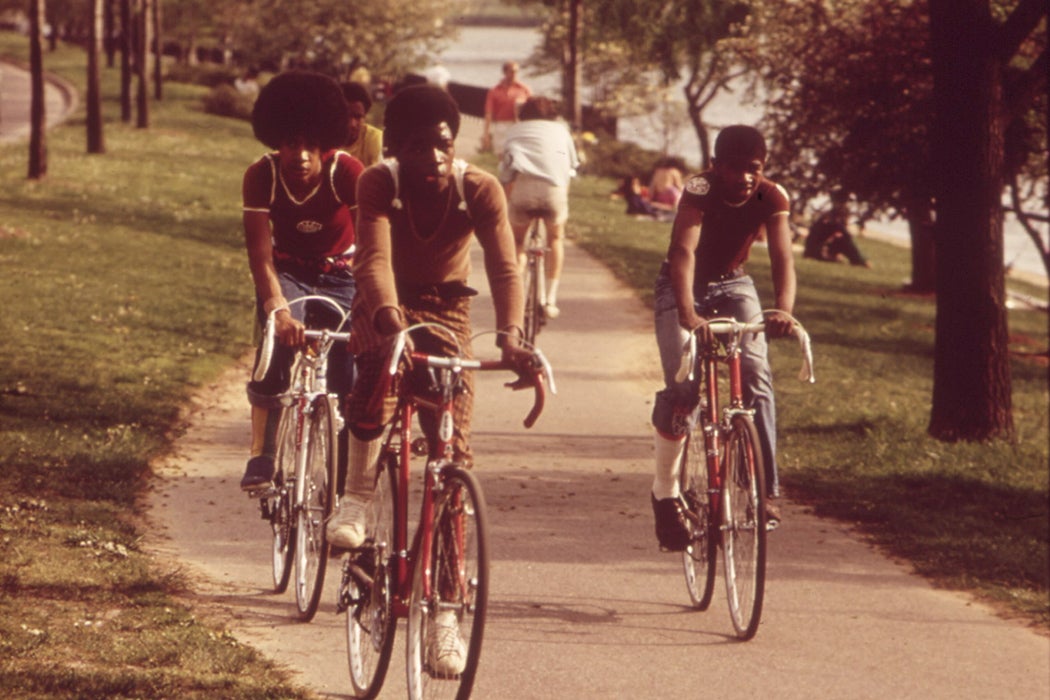The easy mobility inherent in the bicycle has long threatened the racial boundaries of Washington, DC. In the late nineteenth century, Black bicycle club members were jailed for riding in Georgetown without lamps. In 1963, DC’s federally appointed Board of Commissioners criminalized the possession of unlicensed bicycles, with penalties “not more than $300 or imprisonment for not more than ten days.”
The law was “an effort to curb a perceived rash of bicycle thefts in the city,” writes historian John Bloom. It harshly ramped up what had been a matter of juvenile petty crime. Bloom explains that there is no evidence that the Board intentionally passed the law to “enforce racial discrimination,” but soon enough, police were using the bike law to “engage in racially discriminatory policing of public space.” The law gave them “extraordinary powers to stop and question young people in public spaces” a “full decade earlier than the War on Drugs” nationalized pretextual stops of drivers and car passengers.
The mid-1960s are now recognized as a transitional period between the ending of the American version of apartheid known as Jim Crow and the beginning of the era of mass incarceration. Federally funded/mandated law enforcement priorities “attributed African American crimes to alleged racial ‘pathology’” and established a “rationale for aggressive, militarized policing of African American youths.” The Civil Rights era enfranchised Black Americans, but law enforcement whittled away the right to vote (for felons) and buried generations in the living death of the expanding prison system.
In August 1972, a DC police “bicycle stakeout” designed to trap bike thieves resulted in the killing of sixteen-year-old Gregory Coleman. Coleman was shot in the back by a policeman as he pedaled away on an unlocked bike that he got on in front of a Safeway supermarket in the predominantly white Northwest section of the city; Coleman thought the bike was his, which had recently been stolen from him. Police claimed the officer’s gun accidentally fired when it fell from the officer’s holster, something eyewitnesses disputed.
Coleman’s father declared that it “was senseless that my son had to die for a lousy bike,” but, as Bloom shows, it was the logical outcome of way the “culture of mobility that the bicycle offers for youth” became “entangled with both the emergent paradigm of aggressive, racially oriented policing and with the colonial structure of Washington, DC, itself.”
The city of Washington is a political anomaly, carved out of Maryland and Virginia in 1791. After the defeat of Reconstruction, which including a short-lived experiment in multiracial democracy in the District of Columbia (formally recognized in 1801) as elsewhere in the South, a Congress dominated by white supremacists worked to make sure that Blacks in the nation’s capital—about a third of the population in 1871—would be limited in their political power. In 1878, Congress passed a law creating a presidentially appointed Board of Commissioners to rule the District. This lasted until 1967, when President Lyndon Johnson dissolved the Commission and appointed a mayor and nine-member city council.
Citizens of the District were given the right to elect their own mayor and city council in 1973. Congress, however, maintains the right to control the District’s budget—and to override any local law. The 671,000-plus residents of the city can elect a delegate to the US Congress, but that representative—like the ones from America Samoa, Guam, Northern Mariana Islands, Puerto Rico, and the US Virgin Islands—doesn’t have a vote in Congress. (Some states, like Montana and Rhode Island, have congressional districts with fewer people than DC.)
“Federal power over the city allowed the District to become an experimental site for many of the strong anticrime politics enacted in the War on Crime of the 1960s and 1970s,” Bloom writes.
Weekly Newsletter
Lyndon Johnson’s Great Society linked anti-poverty programs with law enforcement reforms, introducing an era of pervasive federal involvement in local policing. The Law Enforcement Assistance Administration (LEAA) was established as part of the Department of Justice in 1968. The agency used DC, which was 70 percent Black by 1970, as “a laboratory” for race-based law enforcement. Tactics included no-knock laws and “investigatory detention,” which allowed DC police to hold people for hours without charge. President Richard Nixon, whose “law and order” strategy was plainly aimed at winning white votes, dedicated one-eighth of the LEAA’s budget to DC, giving the District “the largest police force in the world” per capita.
By 2004, “roughly three out of every four African American males in the District served time behind bars,” writes Bloom. In 2008, DC eliminated its mandatory bicycle registration law.







